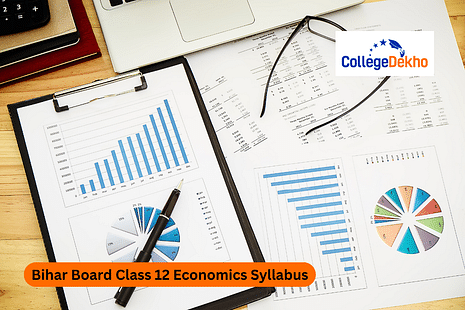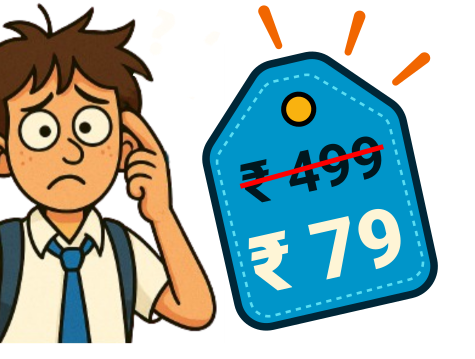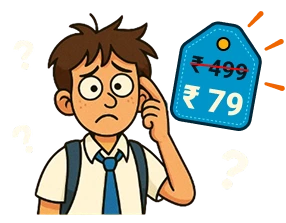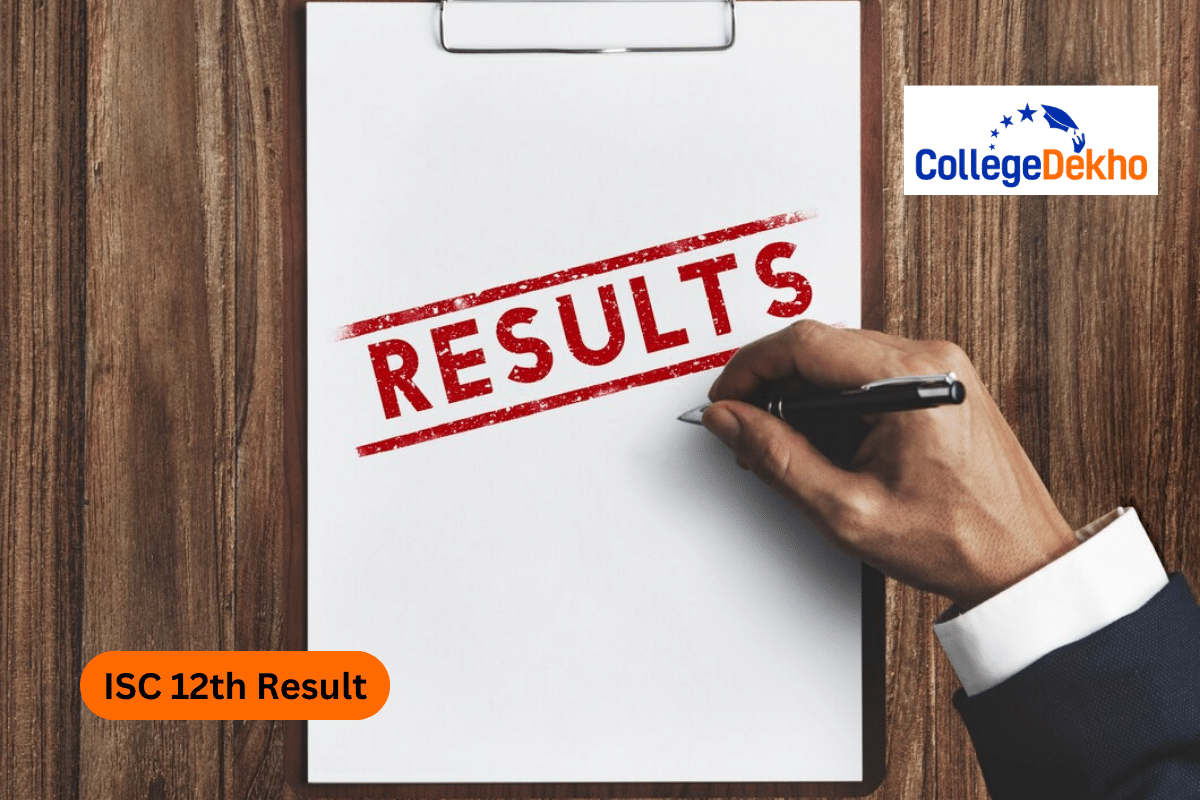

Never Miss an Exam Update
Bihar Board Class 12 Economics Syllabus is uploaded by the Bihar School Examination Board (BSEB) on its official website. The Economics syllabus is mostly divided into two parts that are Macroeconomics and Microeconomics. A total of 10 chapters are included in the syllabus which are equally divided into both parts. No new changes are expected in the syllabus. Students can use the previous year's syllabus to prepare for the board exam since BSEB still needs to upload the latest syllabus.
The total weightage of the question paper in Economics will be 100 marks out of which 50 marks will be allotted to MCQs. Each MCQ will carry 1 mark. The remaining 50 marks will be allotted for subjective type questions which will be further divided into two different sections of short answer type questions and long answer type questions. Students are required to score 33% marks overall to be considered as passing students. Make sure to also check out the BSEB 12th Exam Pattern 2026 for other details. Check out more information about the Bihar Board Class 12 Economics Syllabus 2026 here:
Bihar Board Class 12 Economics Syllabus 2026: Course Structure
Since the latest Economics syllabus is not yet available, students can check out the previous year's syllabus to prepare for the board exams accordingly:
Part A - Introductory Microeconomics
S. No | Chapter Name |
|---|---|
1 | Introduction |
2 | Consumer Behaviour and Demand |
3 | Producer Behaviour and Supply |
4 | Forms of Market and Price Determination |
5 | Simple Applications of Tools of Demand and Supply Curves |
Part B - Introductory Macroeconomics
S. No | Chapter Name |
|---|---|
6 | National Income and Related Aggregates |
7 | Determination of Income and Employment |
8 | Money and Banking |
9 | Government Budget and the Economy |
10 | International Projects in Economics |
Bihar Board Class 12 Economics Syllabus 2026: Chapter-Wise
A total of 10 chapters are included in the Bihar Board Class 12 Economics Syllabus, students can check out the detailed information about the different chapters included in the curriculum here:
Part A - Introductory Microeconomics
Introduction- What is microeconomics?
- Central problems of an economy, production possibility curve, and opportunity cost
- Consumer's Equilibrium - Meaning and attainment of equilibrium through Utility Approach: One and two commodity cases
- Market demand determinants of demand, demand schedule, demand curve, movement along, demand, and shifts in the demand curve.
- Price elasticity demand measurement of price elasticity of demand - percentage, total expenditure, and geometric method.
- Production function: Returns to factors and Returns to sales
- Supply: determinants of supply, supply schedule, supply curve movement along and Supply curve movement along and shifts in supply curve
- Price: elasticity of supply, measurement of price elasticity of supply - percentage and geometric method.
- Cost and Revenue · short-run costs, total costs, total variable cost, total fixed cost, average fixed cost, average variable cost, Marginal meaning, and their relationship. Revenue-total, average, and marginal revenue, Opportunity cost - definition and application
- Producer’s equilibrium - Meaning and its conditions in terms of total cost and total revenue.
- Perfect competition - Features; Determination of market equilibrium and effects of shifts in demand and supply. Other Market Forms - monopoly, monopolistic competition, oligopoly - their meaning and features. Simple Applications of Demand and Supply:
- Simple Applications of Tools of Demand and Supply Curves
- Simple Applications of Demand and Supply: Price ceiling, price floor.
Part B - Introductory Macroeconomics
National Income and Related Aggregates- Macroeconomics: Meaning.
- Circular flow of income, concepts of GDP, GNP, NDP, NNP (at market price and factor cost), National Disposable Income (gross and net); Private Income, Personal Income, and Personal Disposable Income.
- Measurement of National Income: Value-added method, income method, and expenditure method.
- Aggregate demand, Aggregate supply, and their components.
- Propensity to consume and propensity to save (average and marginal)
- Meaning of Involuntary unemployment and full employment.
- Determination of income and employment: Two-sector model. Concept of investment multiplier and its working.
- Problems of excess and deficient demand: Measures to correct excess and deficient demand - availability of credit, change in Government spending.
- Money - meaning, evolution, and functions.
- Inflation: cost-push; demand-pull; causes, effects of inflation on different groups of society; measures to control inflation.
- Central Bank - meaning and functions.
- Commercial banks - meaning and functions.
- Recent significant reforms and issues in the Indian Banking System: Privatisation and Modernisation.
- Government budget - meaning and its components.
- Objectives of the government budget.
- Classification of receipts - revenue and capital
- Taxes - types
- Classification of expenditure - revenue and capital, plan and non-plan & developmental and developmental.
- Balanced budget, surplus budget, and deficit budget: meaning and implications.
- Revenue deficit, fiscal deficit, and primary deficit: meaning and implications; measures to contain different IFB deficits.
- Latest budget of Bihar and India
- Why International Trade takes place
- Balance of payments meaning and components
- Foreign exchange rate - meaning (Fixed and flexible), merits and demerits, Determination through de and supply.
- A brief analysis of recent exchange rate issues.
Part C - Developing Projects in Economics
- To enable the students to develop the ways and means by which a project can be developed using the skills learned in the course.
- This includes all the steps involved in designing a project starting from choosing a title, exploring the pieces of information relating to the title, collecting primary and secondary data, analyzing the data, presenting the project, and using various statistical tools and their interpretation and conclusion.
- To develop a vision for becoming a partner in the development of your area.
Some suggestive examples of projects and case studies are:
- Understanding the demand and supply pattern of your village/mohalla:
- Impact of Inflation on Consumption Pattern
- Role of Self Help Group in thrift and credit promotion. The teachers and learners are encouraged to take on innovative projects.
How to Download Bihar Board Class 12 Economics Syllabus 2026?
Students must follow the simple procedure given below to download their syllabus as soon as it is released by BSEB:
- Step 1: Visit the official website of the Bihar School Examination Board at secondary.biharboardonline.com/
- Step 2: On the homepage, click on the Syllabus option present on the menu bar.
- Step 3: From the drop-down menu, click on the Senior Secondary option.
- Step 4: Now on the new page, select the subject and download the syllabus accordingly.
Bihar Board Class 12 Economics Syllabus 2026: Preparation Tips
Since Economics is a relatively tough subject for the students to crack, they must consider some tips and tricks that will help them to get good marks. Check out some important Bihar 12th Preparation Tips 2026 from the pointers given below:
- First of all, students must complete their syllabus according to the latest PDF released by the Bihar School Examination Board so that they have complete knowledge about the chapters coming in the board exams.
- Making of study plan is also very crucial when preparing for the board exams because it helps the students to calculate the number of days that they need to complete the syllabus and revise.
- Students must consider solving model test papers religiously during their preparations because it helps to gain confidence.
- Making study notes will help the students to revise for the board exams during the last couple of weeks more effectively rather than opening books.
- To write the exam stress-free, students must not pick up any difficult topics before the commencement of the board exams.
The students need to prepare for the board exams by first downloading the detailed syllabus available on the official website of BSEB. Bihar Board Class 12 Economics Syllabus 2026 will include all the important chapters and topics that will be considered when making the question paper for the board exams. You must try to complete the syllabus as soon as possible to be successfully prepared to take the board exam.
FAQs
As per the Bihar Board Class 12 Economics Syllabus 2026, the question paper comprises 50% multiple-choice questions (MCQs) and the rest will be subjective questions.
The total marks allotted for the question paper in Economics will be 100. Students are required to get a total of 33 marks out of the 100 marks to be considered as a “Pass”. Bihar Board Class 12 Economics Syllabus 2026 is divided into two parts.
There are a total of 138 questions including 100 objective questions and 38 subjective questions will be present in the Bihar Board 12th Economics Exam 2026. Out of 100 objective questions, 50 questions have to be answered, and 38 subjective questions, 19 questions need to be answered.
There are a total of 10 chapters divided into two parts, Microeconomics and Macroeconomics in Bihar Board Class 12 Economics Syllabus 2026. In Part A of the Bihar Board 12th Economics syllabus 2026, there are 5 chapters.
Bihar Board Class 12 Economics Syllabus 2026 will be available soon by the Bihar Board on its official website. You can also check and download the syllabus from this page.
Students can refer to various books to prepare their Bihar Board Class 12 Economics Syllabus 2026. Some of the prescribed books include T.S.Grewal, T.R.Jain, V.K.Ohri, etc.
Was this article helpful?



























